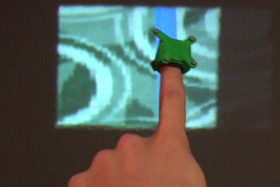« Back to Publications list
Moving Ahead with Peephole Pointing: Modelling Object Selection with Head-Worn Display Field of View
Download Publication File
Abstract
Head-worn displays (HWDs) are now becoming widely available, which will allow researchers to explore sophisticated interface designs that support rich user productivity features. In a large virtual workspace, the limited available field of view (FoV) may cause objects to be located outside of the available viewing area, requiring users to first locate an item using head motion before making a selection. However, FoV varies widely across different devices, with an unknown impact on interface usability. We present a user study to test two-step selection models previously proposed for ‘peephole pointing’ in large virtual workspaces on mobile devices. Using a CAVE environment to simulate the FoV restriction of stereoscopic HWDs, we compare two different input methods, direct pointing, and raycasting in a selection task with varying FoV width. We find a very strong fit in this context, comparable to the prediction accuracy in the original studies, and much more accurate than the traditional Fitts’ law model. We detect an advantage of direct pointing over raycasting, particularly with small targets. Moreover, we find that this advantage of direct pointing diminishes with decreasing FoV.
Publisher Link
http://dx.doi.org/10.1145/2983310.2985756
Citation
Barrett Ens, David Ahlström, Pourang Irani. 2016. Moving Ahead with Peephole Pointing: Modelling Object Selection with Head-Worn Display Field of View. In Proceedings of the 4th symposium on Spatial User Interactions (SUI '16), Tokyo, Japan. ACM, to appear.

Authors

Barrett Ens
Alumni
Dr. David Ahlström
Associate Professor
Pourang Irani
ProfessorCanada Research Chair
at University of British Columbia Okanagan Campus
